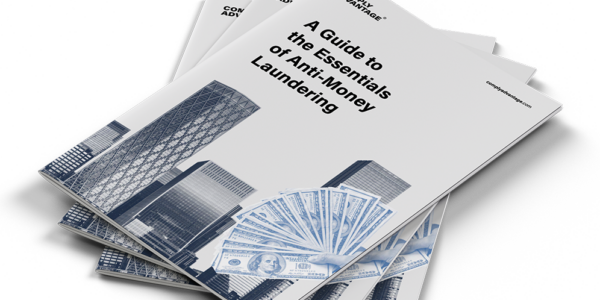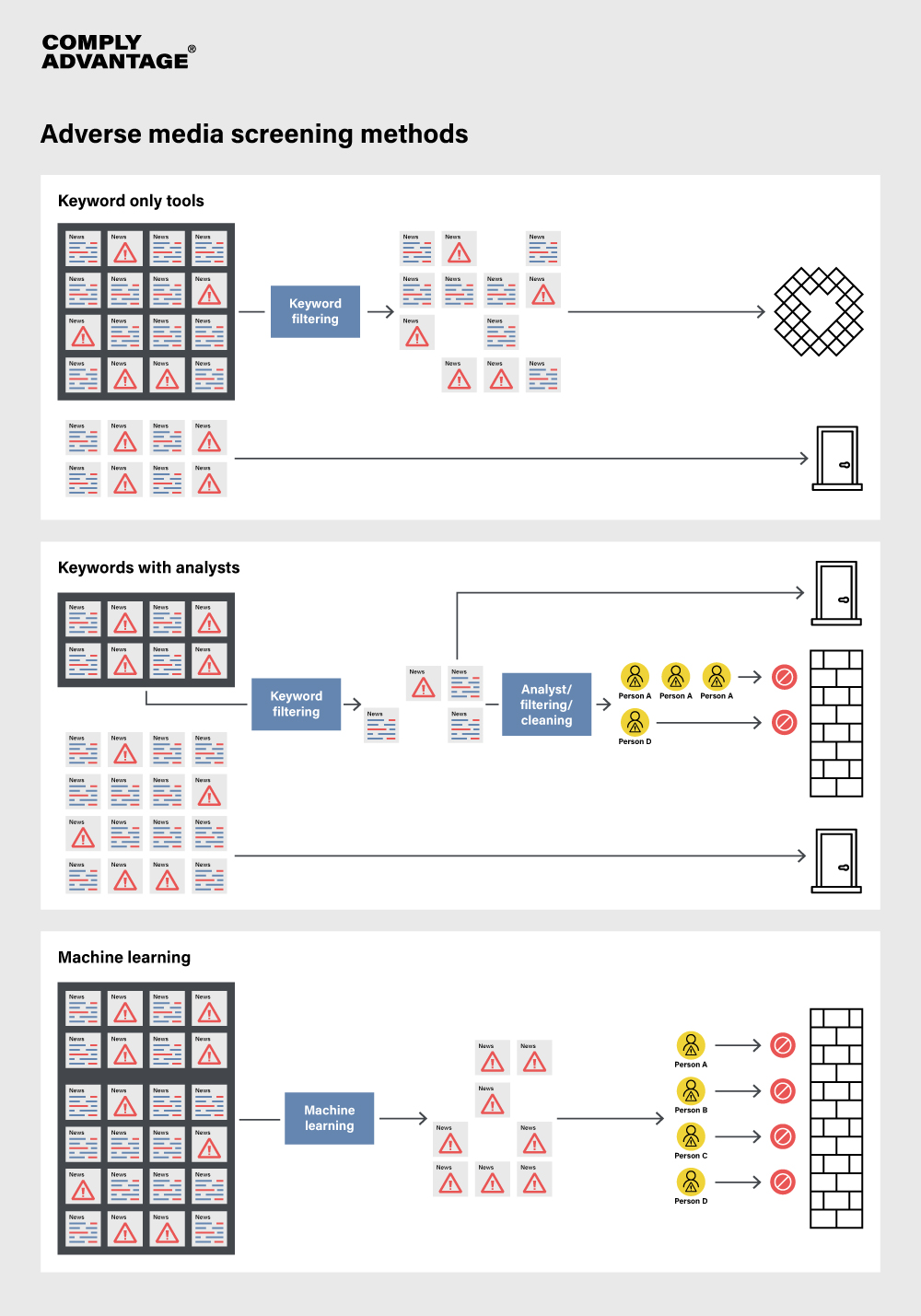
A Guide to the Essentials of Anti-Money Laundering
Our expert guide explains how firms of all sizes can create effective AML programs, build trust with regulators, and turn compliance into a business advantage.
Download your copyAdverse media, sometimes called negative news, refers to information from news and other media sources that suggest an individual or entity may represent a financial crime risk.
Because of the insights adverse media can provide, screening for it forms an essential part of firms’ customer due diligence (CDD) procedures, alongside other types of screening such as sanctions screening and politically exposed person (PEP) screening.
In an ever-expanding media and information landscape, adverse media covers both traditional news sources and newer, sometimes more informal, sources. Taken together, these can include:
Adverse media can give firms a fuller picture of their risk exposure by linking customers to financial crimes including:
It can also shed light on individuals’ or entities’ involvement in other relevant crimes (including predicate offenses in money laundering), such as:
These links pose a serious threat to firms’ reputations and can lead to regulatory and legal repercussions. Firms should therefore implement effective adverse media screening as part of their anti-money laundering and countering the financing of terrorism (AML/CFT) compliance programs.
Adverse media screening requires looking at unstructured or unverified data – unlike other types of screening, which look at official data such as sanctions lists. While it may seem less formal and more subjective than other CDD processes, it can give firms information about potential customers that may not yet be reflected in official sources. This allows for a more holistic view of the risks they face and enables FIs to make fully informed decisions about how much risk they are willing to take on.
The importance of adverse media screening is reflected – although sometimes implicitly or inconsistently – in AML/CFT global regulations. Firms across jurisdictions are legally required to conduct some level of due diligence on customers. This involves verifying their identities, establishing the nature of their relationship with the firm, and assessing their risk level and is clearly required by key AML regulations like:
Adverse media specifically becomes relevant when screening customers for indicators of risk. The Financial Action Task Force (FATF), in its guidance to banks on applying a risk-based approach to AML, specifies “verifiable adverse media searches” as one factor in customer risk assessments.
While the FATF’s guidance is not legally binding, as the global standard-setter for AML, its advice is generally followed by domestic regulators: the Financial Crimes Enforcement Network (FinCEN), for example, has issued similar guidance to US firms. In the EU, the Sixth Anti-Money Laundering Directive (6AMLD) requires firms to carry out enhanced due diligence (EDD) on higher-risk customers, which should include “open source or adverse media searches.” The Australian Transaction Reports and Analysis Center explicitly lists adverse media as one avenue for conducting CDD, while the Monetary Authority of Singapore advises financial institutions (FIs) that they should take “adverse news” into account when assessing risk or filing suspicious transaction reports (STRs).
However, in legal terms the specifics of how firms carry out adverse media screening is often left up to firms. They must therefore understand in depth the challenges of adverse media screening and how best to deal with these.

Our expert guide explains how firms of all sizes can create effective AML programs, build trust with regulators, and turn compliance into a business advantage.
Download your copyUsed properly, adverse media screening can be an invaluable tool for regulated firms, but firms must understand the challenges of implementing it – otherwise, they risk using ineffective or resource-draining screening processes. The challenges include:
When implementing adverse media screening as part of their compliance programs, firms should ensure they have a suitably capable tool dedicated to this process rather than relying on individual searches at onboarding by compliance analysts. In particular, they should make sure their screening solution can help them:

When designing and implementing an adverse media screening program, firms need to consider which approach to take. Each has a role in different kinds of institutions – the choice ultimately depends on an organization’s needs, risk appetite, and resources. However, firms seeking scalability and long-term precision often benefit most from adopting ML solutions, complemented by expert oversight for critical decision-making.
ComplyAdvantage assists regulated firms with market-leading adverse media screening, adding 5x more profiles than competitors each month. With a bespoke, collaborative integration process, ComplyAdvantage gives FIs like Allianz Benelux an efficient way of understanding customer risks with adverse media.
“We were looking for an efficient tool to perform adverse media checks. It had to be easy to use, with efficient support, and the price was also important. In-house, we consider the support we receive from ComplyAdvantage to be the best we have ever received. If you’re looking for an adverse media solution, it would be a mistake not to explore ComplyAdvantage’s proposed solution.”
Yves Declercq, AMLCO Compliance Officer, Allianz Benelux
ComplyAdvantage’s adverse media screening solution helps firms to:
1000s of organizations like yours are already using ComplyAdvantage. Learn how to streamline compliance and mitigate risk with industry-leading solutions.
Get a demoOriginally published 09 December 2017, updated 14 February 2025
Disclaimer: This is for general information only. The information presented does not constitute legal advice. ComplyAdvantage accepts no responsibility for any information contained herein and disclaims and excludes any liability in respect of the contents or for action taken based on this information.
Copyright © 2025 IVXS UK Limited (trading as ComplyAdvantage).